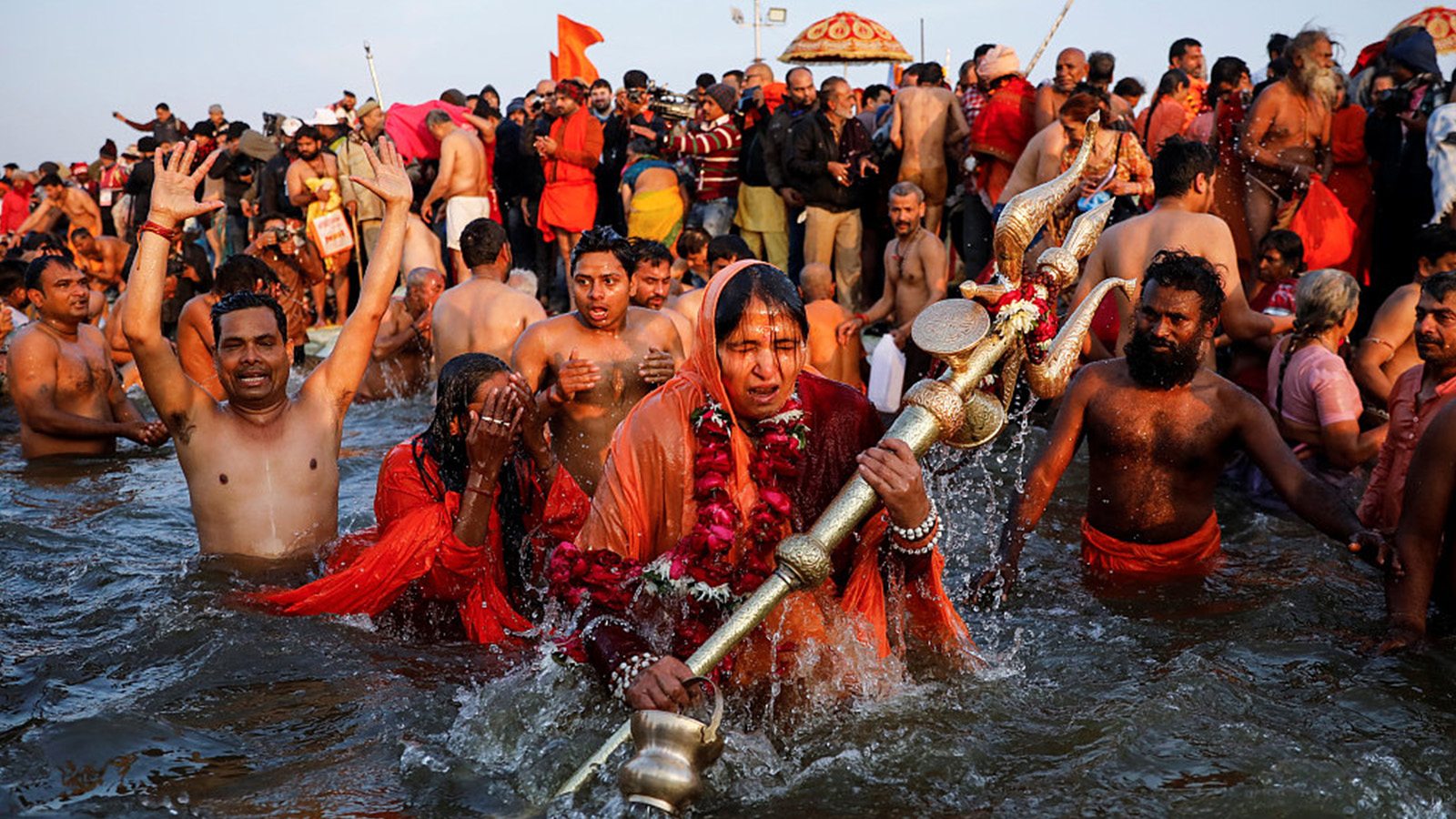Some 140 million people at one location. Yes, the world's second most populous country is hosting a mega faith carnival called Kumbh Mela. "Kumbh" literally means "pot", and the Kumbh Mela is held every three years and switches between four different locations – Haridwar, Prayagraj, Ujjain, and Nasik, all along the banks of India's sacred rivers. The festival returns to each location after a span of 12 years.
Hindus believe that during the 49-day festival, the waters of sacred rivers turn into holy "nectar" and taking a dip in the "pitcher of nectar" will help adherents to wash away their sins and attain salvation. The exact dates of the festival are calculated according to the combination of the zodiac positions of Jupiter, the Sun and the Moon.
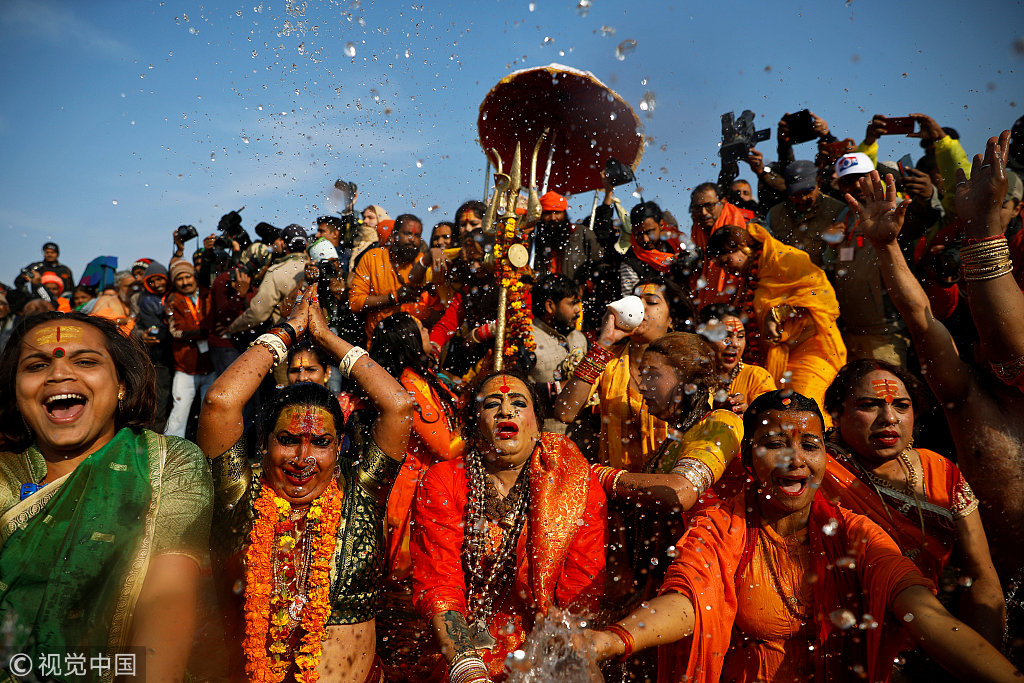
Lakshmi Narayan Tripathi (C), chief of the congregation for transgender people "Kinnar Akhada," takes a holy dip with other members of the community in Prayagraj, Uttar Pradesh, India, January 15, 2019. /VCG Photo
Lakshmi Narayan Tripathi (C), chief of the congregation for transgender people "Kinnar Akhada," takes a holy dip with other members of the community in Prayagraj, Uttar Pradesh, India, January 15, 2019. /VCG Photo
This year the Ardha Kumbh Mela began on January 15 and will last until March 4. Devotees from across the globe are expected to participate in what is called the largest congregation of religious pilgrims in the world.
The 2,000-year-old tradition was first mentioned in the accounts of Hiuen Tsang (Xuanzang), an ancient Chinese traveler who visited India between 630-645 AD.
Kumbh Mela: Let's talk business
But this larger-than-life festival of faith, spirituality, and religion is pure "nectar," even for one of the world's fastest-growing economies.
The provincial government of the northern Indian state of Uttar Pradesh has allocated 4,200 crore Indian rupees (nearly 589 million U.S. dollars) for the mega-pilgrimage, making it the costliest Kumbh Mela ever.
According to the latest report by the Confederation of Indian Industries (CII), the Ardha Kumbha Mela is expected to generate over 1.2 lakh crore Indian rupees (about 16.8 billion U.S dollars) in revenues.
The economic activities associated with the festival will generate employment for over 600,000 workers across various sectors, as per the CII report.

An Indian sadhu (Hindu holy man) takes a dip at the holy Sangam in Prayagraj, Uttar Pradesh, India. /VCG Photo
An Indian sadhu (Hindu holy man) takes a dip at the holy Sangam in Prayagraj, Uttar Pradesh, India. /VCG Photo
The revelry attracts tourists from countries like Australia, New Zealand, South Africa, Mauritius, Singapore, UK, and Sri Lanka. Hence, the report says the hospitality sector aims to employ 250,000 people, airlines and airports around 150,000 and tour operators around 45,000. The employment numbers in medical and eco-tourism are being estimated at 85,000. Apart from this, around 55,000 new jobs are expected to be created in the informal sector which encompasses taxi drivers, tour guides, interpreters and volunteers.
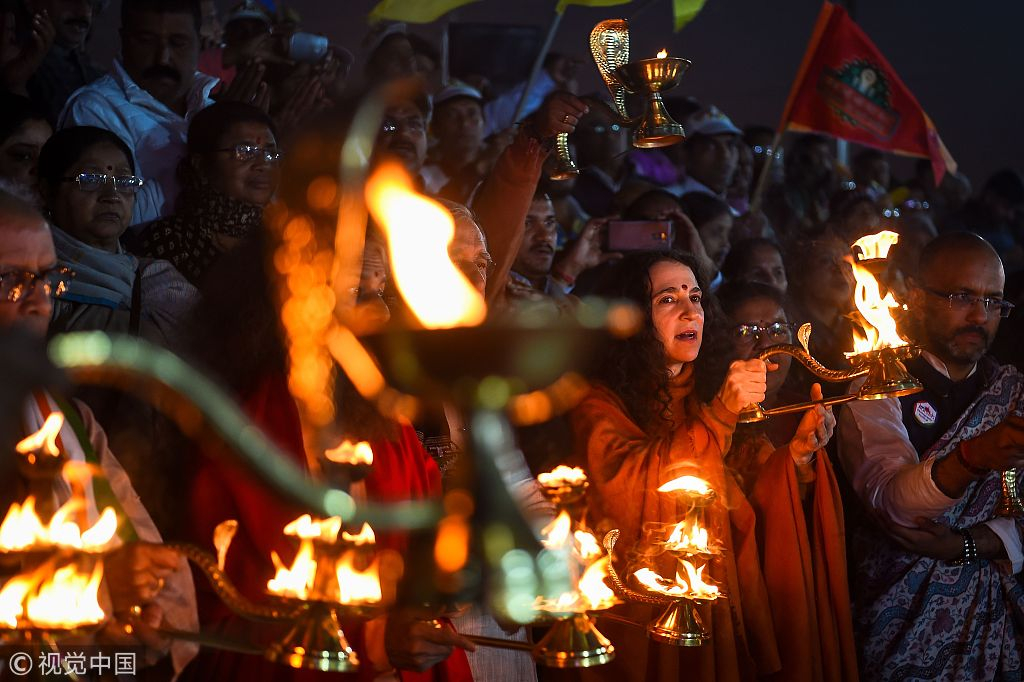
Sadhvi Bhagawati Saraswati, U.S. secretary-general of Global Interfaith WASH Alliance, offers prayers at the holy Sangam in Prayagraj, Uttar Pradesh, India, January 16, 2019. /VCG Photo
Sadhvi Bhagawati Saraswati, U.S. secretary-general of Global Interfaith WASH Alliance, offers prayers at the holy Sangam in Prayagraj, Uttar Pradesh, India, January 16, 2019. /VCG Photo
An entire city has been set up spanning 2,500 hectares at Prayagraj, where the authorities have erected a mini-city of over 4,000 tents which are lit by 40,000 LED lights. The carnival area involves 250 kilometers of road and 22 pontoon bridges making it the largest temporary city in the world. This year the authorities have also introduced 200 luxury and 250 deluxe tents costing up to 35,000 Indian rupees (around 490 U.S. dollars) per night.
The Indian Railways has commissioned 41 projects at a cost of 700 crore Indian rupees (98 million U.S. dollars) for the Kumbh Mela. Some 800 special trains are running from various stations of Allahabad district. The Inland Waterways Authority of India (IWAI) has set up four floating terminals for pilgrim movement. The government also plans to start an airboat service.
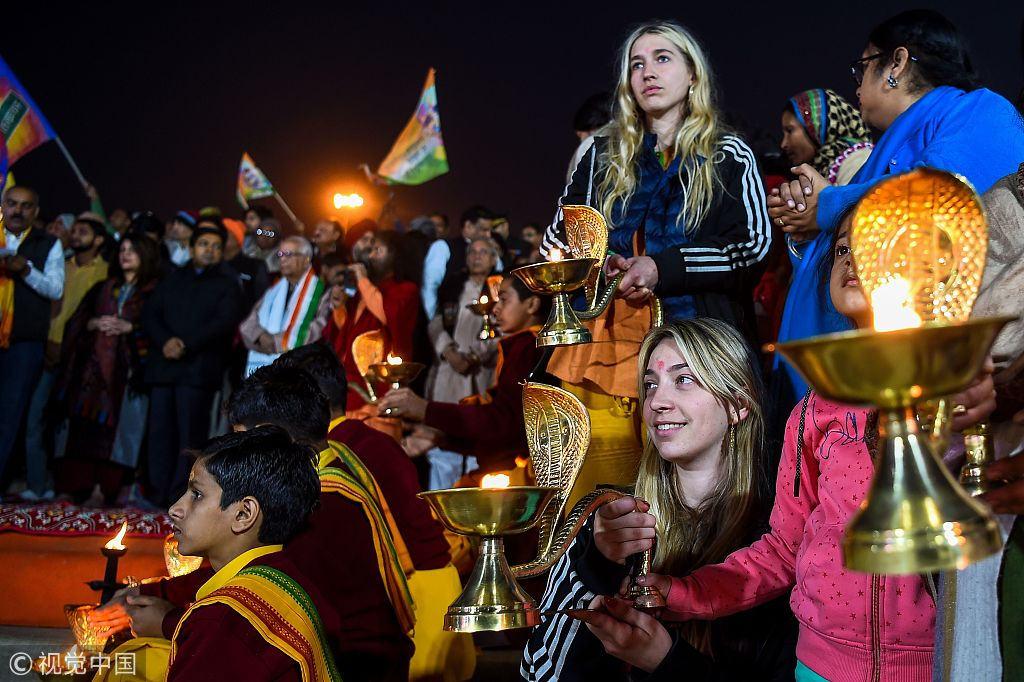
Foreign devotees offer prayers at the holy Sangam in Prayagraj, Uttar Pradesh, India, January 16, 2019. /VCG Photo
Foreign devotees offer prayers at the holy Sangam in Prayagraj, Uttar Pradesh, India, January 16, 2019. /VCG Photo
Kumbh goes digital
Two siblings lost in Kumbh only to reunite years later is a common plot in Bollywood movies inspired by similar real-life sordid sagas. Nearly 300,000 people were reported missing in 2013 during the Kumbh Mela but unlike earlier times, 99 percent of them were later reunited.
This year Uttar Pradesh police have set up a fully computerized "lost and found" center in coordination with an IT firm. Face recognition software has also been installed to trace people with the help of a photograph.
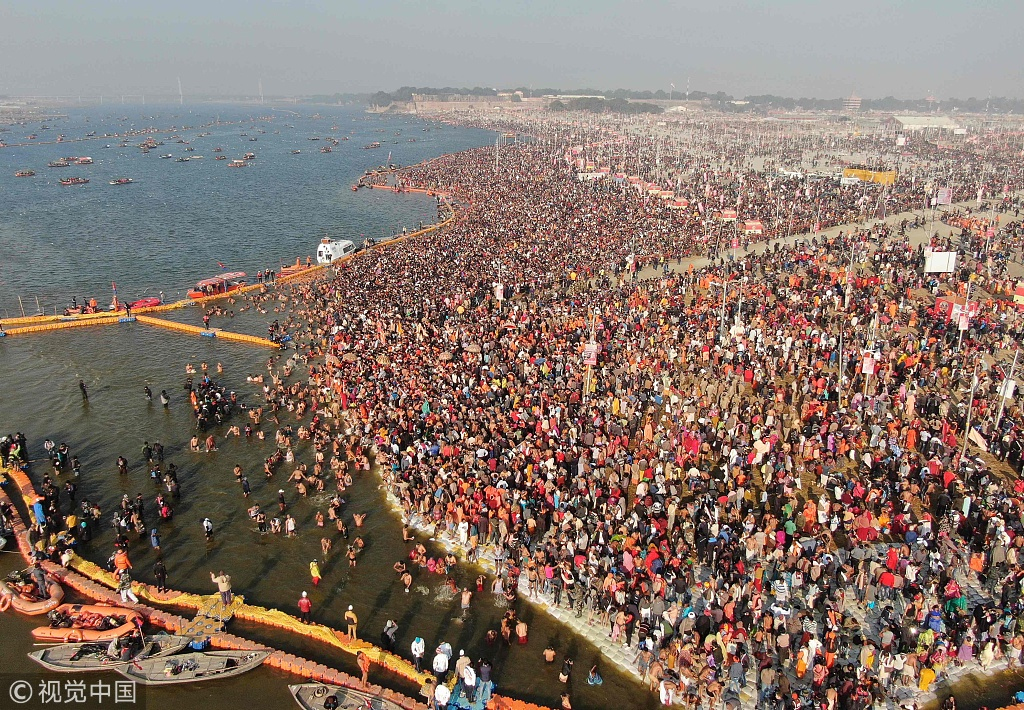
An aerial view of the five-kilometer main bathing place at the holy Sangam in Prayagraj, Uttar Pradesh, India, January 15, 2019. /VCG Photo
An aerial view of the five-kilometer main bathing place at the holy Sangam in Prayagraj, Uttar Pradesh, India, January 15, 2019. /VCG Photo
Stampedes are another constant threat. Railway authorities have installed IBM Intelligent Video Analytics for crowd control at the stations and its adjoining areas. In 2013, 36 people died in a crush at a Prayagraj train station. In 1954, more than 500 people were killed when an elephant charged a dense crowd.
A mobile app has also been developed by state police to guide the visitors in hunting hotels, bus stations, and train ticket counters.
The purest is also the most polluted
According to Hindu mythology, the water of Ganga river has miraculous healing powers which give people hope of life. Ironically, today, Ganga is considered the sixth-most polluted river in the world.
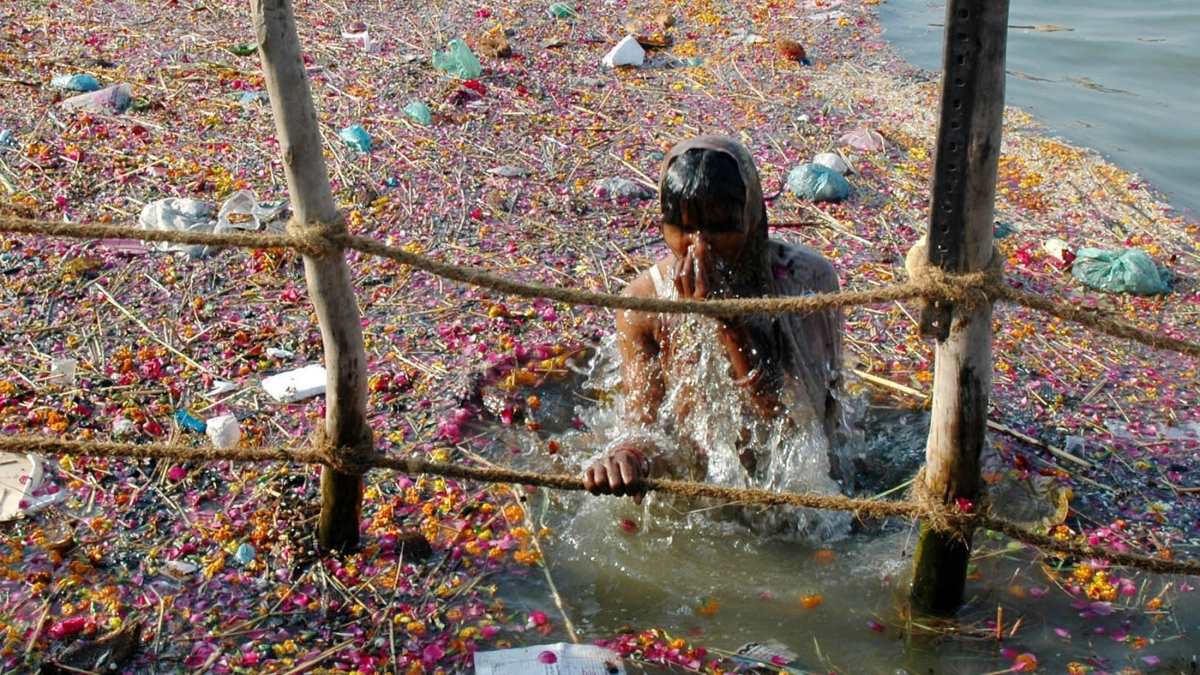
A devotee taking a dip in polluted Ganga river in Kanpur, Uttar Pradesh, India, April 2017. /Reuters Photo
A devotee taking a dip in polluted Ganga river in Kanpur, Uttar Pradesh, India, April 2017. /Reuters Photo
After the 2013 Kumbh Festival, pollution levels rose alarmingly on the first day of the holy dip. A study by the Uttar Pradesh Pollution Control Board found Biochemical Oxygen Demand levels had increased to 7.4 milligrams per liter in the main bathing place, much higher than the permissible limit of two milligrams per liter. Simply put, the water was unfit for bathing or drinking.
This year, the Uttar Pradesh government has ordered the shutdown of tanneries in the adjoining cities from December 15 to March 15 to ensure clean water for the pilgrims.

